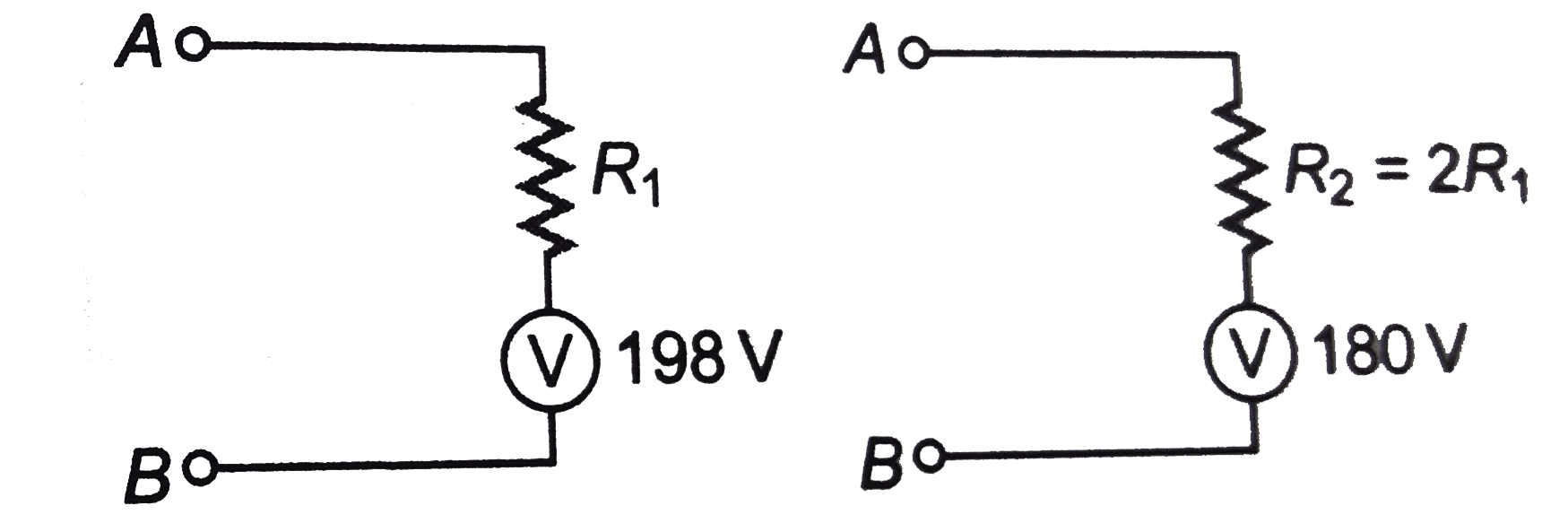A voltmeter connected in series with a resistance R1 to a circuit indicates a voltage V1=198V. When a series resistor R2=2R1 is used, the voltmeter indicates as voltage V2=180V. If the resistance of the voltmeter is RV=900Ω, then the applied voltage ( in volt ) across A and B is

The correct Answer is:220
In series PD distribution in direct ratio of resistance
In first case
198VAB−198=900R1 ………i
In second case 180VAB−180=9002R1……….ii
Solving the two equations, we get
VAB=220V
Topper's Solved these Questions
- BOOK - DC PANDEYCHAPTER - CURRENT ELECTRICITYEXERCISE - Level 2 More Than One Correct10videos
CURRENT ELECTRICITY
- BOOK - DC PANDEYCHAPTER - CURRENT ELECTRICITYEXERCISE - Level 2 Comprehension Example Type2videos
CURRENT ELECTRICITY
- BOOK - DC PANDEYCHAPTER - CURRENT ELECTRICITYEXERCISE - Level 1 Subjective53videos
CURRENT ELECTRICITY
- BOOK - DC PANDEYCHAPTER - COMMUNICATION SYSTEMEXERCISE - Subjective11videos
COMMUNICATION SYSTEM
- BOOK - DC PANDEYCHAPTER - ELECTROMAGNETIC INDUCTIONEXERCISE - Medical entrances gallery25videos
ELECTROMAGNETIC INDUCTION
Similar Questions
A resistance ΔR=1980 Ω is connected in series with a voltmeter when its scale divisons decreases η=10%. Calculate the resistance R_(V) of the voltmeter.
View SolutionA 100V voltmeter having an internal resistance of 20kΩ is connected in series with a large resistance R across a 110V line. What is the magnitude of resistance R if the voltmeter reads 5V?
View Solution
Knowledge Check
- Question 1 - Select One
An alternating voltage is connected in series with a resistance R and inductance L if the potential drop across the resistance is 200V and across the inductance is 150V, then the applied voltage is
A350VB250VC500VD300V - Question 2 - Select One
A 100V voltmeter of internal resistance 20kΩ in series with a high resistance R is connected to a 110V line. The voltmeter reads 5V, the value of R is
A210ΩB315ΩC420ΩD400Ω - Question 3 - Select One
A 100Ω resistance is connected in series with a 4H inductor. The voltage across the resistor is VR=2sin(1000t)V. The voltage across the inductors is
A80sin(1000t+π2)B40sin(1000t+π2)C80sin(1000t−π2)D40sin(1000π−π2)
A 150 V voltmeter has a resistance of 20,000Ω when connected in series with a large resistance R across a 110-volt line the meter reads 5V. Find the resistance R.
View SolutionA voltmeter with resistance 2500Ω indicates a voltage of 125V in the circuit shown in figure. What is the series resistance to be connected ot voltmeter so that it indicates 100V? Consider ideal battery.
 View Solution
View SolutionAn ammeter, voltmeter and a resistor are connected in series to a cell and the readings are noted as I and V. If another resistor R is connected in parallel with a voltmeter, then
View SolutionA 100 V voltmeter of internal resistance 20 kω is in series with a high resistance R, is connected to 110 V line . The voltmeter reads 5 V, then the value of R is
View SolutionA 100 V voltmeter of internal resistance 20kΩ n series with a high resistance R is connected to 110 V line. The voltmeter reads 5V, the value of R is -
View Solution

